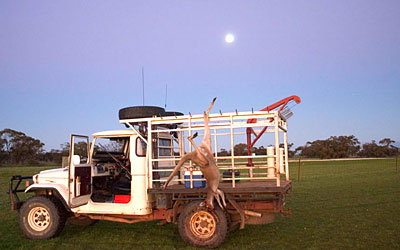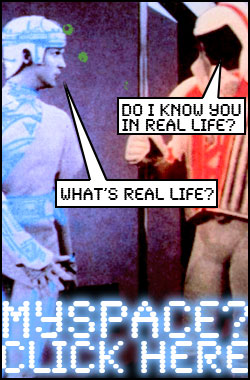Roo Shooter, Part 2

My girlfriend took care of me the best that she could, and I managed occasional work as a dishwasher, furniture mover, and stonemason. But my meagre income was eating into my pride. I was tired of the wide, silver paint-lined grins that the Aborigines at the city center always flashed when they saw me shoplifting my meals. I was tired of shoplifting my meals.
Then Craig rang.
“G’day…is that Jeff?” It was.
“This is Craig Murphy. Steve Evans told me you was looking for a bit of work as an offsider to a ‘roo shooter.” That was true, yes.
“Well, I’m getting’ ready to go up to Nookawarra out bush for a couple days and I could use a bit of help. I can’t lift the boomers onto the Ute like I used to, and I’m lookin’ for someone to work the light and go get the ‘roos after I shoot ‘em. I’ll take you up there, take care of all your food, and offer you 400 bucks flat.” Sounded cool to me.
“I’ll meet you Monday at the train station,” Craig said. “Bring a couple pillows and a towel and some clothes you can get messy. We leave Tuesday morning, first thing.”
***
The kangaroo is a striking, strange creature, at once silly and majestic like the moose. It’s also the primary symbol of Australia. Portrayed on the national coat of arms, the creature has been used to advertise and anthropomorphize the Australian psyche all over the world. Not only does it adorn everything Australia produces—from postcards to foodstuff logos, from children’s books to novelty t-shirts—but it has proudly crept into the vernacular. In a nation that derogatorily calls its aboriginals “boongs,” its Asians “slants,” and its Italians “wogs,” white Aussies are referred to as “skips.”
For the Australians, the kangaroo is both a boon and pest, a national icon and creature to despise. The country is overrun with them—58 million, according to the latest census, making the species amongst the most common wild land mammal on earth. This, ironically, is mostly thanks to a sheep and cattle industry that have created an abundance of man-made pasture grasses and watering holes, and have driven dingoes—the kangaroos only predators, but “vermin” to sheep farmers—into the center of the country. These cute, fuzzy hoppers now pose a serious environmental threat to the rangelands. Travelling in packs of several hundred, they can easily cover up to 500 kilometers. A pod can bisect a farm on one of these journeys and cause thousands of dollars’ worth of damage to valuable crops in a single night, wrecking fences and outgrazing cattle for rare desert grass.
Consequently it’s perfectly legal in Australia to kill kangaroos, but not all kangaroos. Only the four most plentiful species can be commercially harvested. And it’s not indiscriminate, but part of a far-reaching Management Plan drawn up by the Federal conservation Department. The Plan is basically a system of population monitoring and quota setting. After deciding on a maximum allowable “take” for a given year,the States Authority sells individually and sequentially numbered plastic lockable tags. To qualify as a legal kill each kangaroo must be tagged, and he circulation of these tags are also closely watched to ensure the harvest in any one area doesn’t top the quota.
So if you’re a licensed hunter, you buy tags from the government, load up a truck with a weeks’ worth of food, water and fuel and drive out into the bush to slaughter as many kangaroos as you can safely carry. You then lug the carcasses into town and sell them to a kangaroo processor. Processors will only buy those beasts you’ve humanely killed (i.e. head-shot as opposed to “skin only” which targets the legs and the neck). It works in everyone’s best interest this way: the ‘roos are killed humanely, and processors don’t buy meat that’s been contaminated with lead bullets.
The culling is vast. At its highest, in 2002, total deaths hit seven million. Twenty percent of Australia's kangaroo population was wiped out in a single year. Little surprise, then, that the animals are now seen by many as natural resource, with the processing of their body parts one of Australia’s fastest-growing industries. Kangaroo meat is now considered a delicacy outside of Australia and exported to fifty-five countries. The soft hides are highly prized by tanneries for being very durable, yet light in weight. The kangaroo economy brings in over $200 million dollars per year and employs about 4,000 people.
Craig is a professional “harvester”, and has been shooting the animals since he was eight years old. “Most weeks, if we wanted to eat meat, we shot a ‘roo. That’s how it was in early days, mate.” After finishing high school, Craig trained as a roof carpenter, supplementing his income with money earned from ‘roo shooting trips and occasional work as an oil driller. Apparently he had never worn a shirt to work, either—the man looked like a crocodile hide stretched over giant sack of rice.
I imagine that most licensed hunters are like Craig, men who grew up in the bush their entire lives with kangaroo killing as part of the lifestyle. The most vocal of the four kangaroo shooter associations—The NSW Professional Kangaroo Cullers—have stated they’d like to see shooters recognised as a full time occupation, much like fishing. And interest does seem to be high: 6,236 occupier licences were issued for the commercial zone in 1999 and 5,130 in 2000.
That said, no one in their right mind would classify commercial kangaroo shooting as a career with long-term prospects. It's certainly not the type of work you'd take up if there was something better to do. Nor is kangaroo shooting an aspect of Australian culture that is particularly revered or immortalized. Even the gruffest, grizzliest shooter recognizes the job has some nasty aspects and puts it behind him as quickly as possible. Craig confided in me that he no longer dreamed when he slept.
*********
This is part two of a five-part story. Click here for parts one, two, three, four, or five.





6 Comments:
Wait, did this really happen to you?
Bloody oath it did, mate.
Wow. I hope you tell us more about this experience. I had no idea. What an intriguing experience.
Wow I just said experience in a matter of four sentences. Need to beef up the vocab!
I love shooting animals in plain open fields that don't move faster than 2 kmph too.
Post is wasteful + the bloody carcass is tacky.
That's not hunting bro.
Work at home opportunites For people who are smart enough to go after there own dreams
Work from home opportunites
Women who have children will love it...
Post a Comment
<< Home